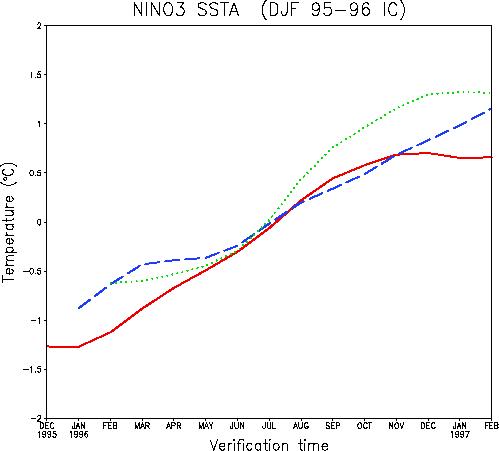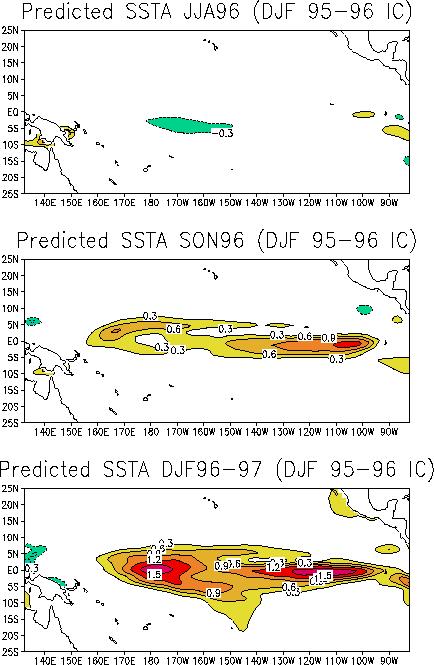[Next Article] -
[Previous Article]
Tropical Pacific SST Predictions with a Coupled GCM
contributed by Ben Kirtman, Bohua Huang, J. Shukla and Zhengxin Zhu
Center for Ocean-Land-Atmosphere Studies, Calverton, Maryland
The Center for Ocean-Land-Atmosphere Studies
(COLA) has recently developed an anomaly coupled
prediction system, using sophisticated dynamical ocean
and atmosphere models, that produces skillful forecasts
of the tropical Pacific sea surface temperature anomaly
(SSTA) up to 1.5 years in advance. The details of this
coupled prediction system are described by Kirtman et
al. (1996b) and a brief description of the overall skill of
the 30 hindcast predictions was given in the March
1995 issue of this Bulletin. The atmospheric component
is the COLA atmospheric general circulation model
(AGCM; Kinter et al. 1988) that includes a state-of-the-art land surface model (Xue et al. 1991) and physical
parameterizations of radiation, convection, and
turbulence. The AGCM is a global spectral model that
is horizontally truncated at triangular wavenumber 30
and has 18 unevenly spaced sigma levels in the vertical.
The oceanic component is a Pacific basin version of the
Geophysical Fluid Dynamics Laboratory (GFDL) ocean
model (Pacanowski et al. 1993). In the ocean model
there are 20 levels in the vertical with 16 levels in the
upper 400 m. The zonal resolution is 1.5o longitude and
0.5 o latitude between 20oN and 20 oS. Further details of
the ocean model are provided in Huang and Schneider
(1996).
We have separately tested the ocean and
atmosphere component models in order to evaluate their
performance when forced by observed boundary
conditions and improvements have been made that are
also incorporated into the coupled prediction system.
The effects of atmospheric model zonal wind stress
errors have been ameliorated by using the zonal wind at
the top of the boundary layer to redefine the zonal wind
stress at the surface (Huang and Shukla 1996). We have
also developed an iterative procedure for further
adjusting the zonal wind stress, based on the simulated
SSTA errors, that improves initial conditions for
coupled forecasts (Kirtman et al. 1996a).
The Niño 3 SSTA root mean squared error
(RMSE) and correlation as a function of forecast lead
time was shown in the March 1995 issue of this
Bulletin. The RMSE and the correlation are computed
with respect to the observed SSTA. The correlation in
the Nino 3 region remained above 0.6 for lead times of
up to 12 months and was larger than that of the
persistence forecast for all lead times greater than 3
months.
Figure 1 shows the time series of the predicted
SSTA in the Niño 3 region for the three forecasts
initialized on December 1, 1995, January 1 and
February 1, 1996. Each forecast is run through February
1997. All three forecast show a consistent evolution
with relatively cool temperatures in the boreal winter of
1995-96 and a fairly rapid transition to relatively warm
temperatures in the boreal winter of 1996-97. The
predicted SSTA anomalies are near normal during
summer 1996. In the forecasts initialized in December
1995 and February 1996, the warm anomalies plateau
during the boreal winter of 1996-97 while the forecast
initialized in January 1996 shows continued warming.
The warming trend seen in all three of these predictions
is consistent with forecasts initialized in September
1995 and November 1995 shown in the December 1995
issue of this Bulletin.
The ensemble mean (average of all three
forecasts) horizontal structure of the predicted SSTA
for the boreal summer of 1996, fall of 1996 and winter
of 1996-97 are shown in the three panels of Fig. 2. The
ensemble averaged forecast indicates warm SSTA
beginning in the boreal fall of 1996 with anomalies in
excess of 1C over much of the central Pacific between
5S-5N during winter 1996-97. During summer 1996
the conditions are near normal with weak cold
anomalies in the western Pacific.
Acknowledgments: This research is part of a larger
group effort at COLA to study the predictability of the
coupled system. Many members (D. DeWitt, M.
Fennessy, J. Kinter, L. Marx and E. Schneider) of this
group have provided invaluable advice. L. Kikas
assisted in managing the data. This work was supported
under NOAA grant NA26-GP0149 and NA46-GP0217
and NSF grant ATM-93-21354.
References
Huang, B., and J. Shukla, 1996: An examination
of AGCM simulated surface stress and low level winds
over the tropical Pacific ocean. Mon. Wea. Rev., 124, in
press.
Huang, B., and E. K. Schneider, 1995: The
response of an ocean general circulation model to
surface wind stress produced by an atmospheric general
circulation model. Mon. Wea. Rev., 123, 3059-3085.
Kinter, J. L. III, J. Shukla, L. Marx and E. K.
Schneider, 1988: A simulation of winter and summer
circulations with the NMC global spectral model. J.
Atmos. Sci., 45, 2486-2522.
Kirtman, B. P., J. Shukla, B. Huang, Z. Zhu, E. K.
Schneider, 1996a: Multiseasonal predictions with a
coupled tropical ocean global atmosphere system. Mon.
Wea. Rev., 124, in press.
Kirtman, B. P., E. K. Schneider and B. Kirtman,
1996b: Model based estimates of equatorial Pacific
wind stress. J. Climate, 124, in press.
Pacanowski, R. C., K. Dixon, A. Rosati, 1993:
The GFDL modular ocean model users guide, version
1.0. GFDL Ocean Group Tech. Rep. No. 2.
Reynolds, R.W., and T. M. Smith, 1995: A high
resolution global sea surface temperature climatology.
J. Climate, 8, 1571-1583.
Xue, Y., P. J. Sellers, J. L. Kinter III, and J. Shukla,
1991: A simple biosphere model for global climate
studies. J. Climate, 4, 345-364.
Figures

Figure 1. Time evolution of the Nino 3 SSTA forecast. The solid
(dashed) [dotted] curve corresponds to the forecast initialized in
December 1995 (January 1996) [February 1996].

Figure 2. The ensemble mean
SSTA. The top panel shows the predicted ensemble mean averaged over
Jun-Jul-Aug 1996, the middle panel averaged over Sep-Oct-Nov 1996,
and the bottom panel Dec-Jan-Feb 1996-97.
[Purpose] -
[Contents] -
[Editorial Policy] -
[Next Article] -
[Previous Article]

